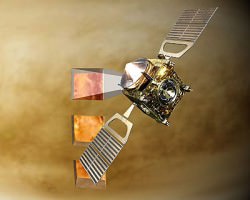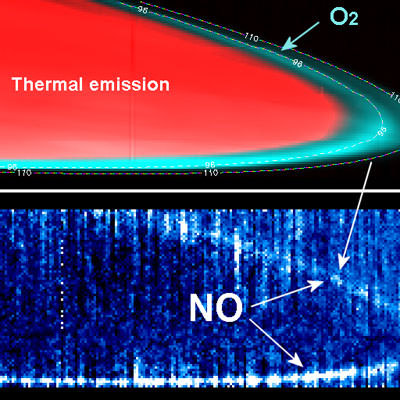[/caption]
Venus is glowing in infrared! At least at night, anyway. The Venus Express spacecraft has observed an eerie glow in the night-time atmosphere of Venus. This infrared glow comes from nitric oxide and is showing scientists that the atmosphere of Earth’s nearest neighbor is a temperamental place of high winds and turbulence. Since this glow is infrared, we can’t see it with our eyes but lucky for us, the ESA’s spacecraft is equipped with the Visible and Infrared Thermal Imaging Spectrometer (VIRTIS) instrument, which can see these wavelengths. A glow like this has never been detected in the atmospheres of Earth or Mars, even though nitric oxide molecules are present. So just why is Venus glowing, and what is this glow telling us?
“The nightglow can give us a lot of information,” says Antonio García Muñoz, who was at the Australian National University when the research was carried out; he is now located at the Instituto de Astrofísica de Canarias, Tenerife, Spain. “It can provide details about the temperature, wind direction, composition and chemistry of an atmosphere.”
VIRTIS has made two clear-cut detections of the so-called nightglow for nitric oxide at Venus. This is the first time such infrared detections have been made for any planet and provide a new insight into Venus’s atmosphere
The nightglow is ultimately caused by the Sun’s ultraviolet light, which streams into a planet’s atmosphere and breaks the molecules up into atoms and other simpler molecules. The free atoms may recombine again and, in specific cases, the resulting molecule is endowed with some extra energy that is subsequently lost in the form of light. On the day-side of the planet, any atoms that do find their way back together are outshone by the sunlight falling into the atmosphere.
But on the night-side, where atoms are transported by a vigorous diurnal circulation, the glow can be seen with appropriate instruments, such as VIRTIS.
It also highlights a new mystery. “These results show that there could be at least twice as much hydrogen in the upper atmosphere of Venus than we thought,” says Delva. The detected hydrogen ions could exist in atmospheric regions high above the surface of the planet; but the source of these regions is unknown.

The nightglow on Venus has been seen at infrared wavelengths before, betraying oxygen molecules and the hydroxyl radical, but this is the first detection of nitric oxide at those wavelengths. It offers data about the atmosphere of Venus that lies above the cloud tops at around 70 km. The oxygen and hydroxyl emissions come from 90-100 km, whereas the nitric oxide comes from 110-120 km altitude.
Yet, even VIRTIS cannot see the nitric oxide nightglow all the time because it is often just too faint. “Luckily for us, Venus has a temperamental atmosphere,” says García Muñoz, “Packets of oxygen and nitrogen atoms are blown around.” Sometimes these become dense enough to boost the brightness of the nightglow, making it visible to VIRTIS.
Venus Express can observe the three nightglow emissions simultaneously, and this gives rise to a mystery. The nightglows from the different molecules do not necessarily happen together. “Perhaps when we have more observations, we will understand the correlation between them,” says García Muñoz.
In order to do that, the VIRTIS team plans to continue monitoring the planet, building up a database of this fascinating phenomenon.
Source: ESA


“Venus is glowing in infrared!”
You write that like it’s a surprise… ???
“At least at night, anyway.” So might the day side be absolute zero?
Quite a wind there, if it breaks nitrogen and oxygen molecules to (packets of) atoms. Or somefink!
When it comes to the ‘Goldilocks porridge’
it is not only too hot, but poisonous!!!!
According to the many articles I’ve read about
Venus, the temperature is ~860F or 460C
day and night!!!!. This will FOREVER be a place off limits for humans!!!! (I realize Never or Forever is very strong words but I see no hope for Venus to be human friendly!!!)
Rather than attempting to colonize Venus’ hostile surface, man might colonize the Venusian atmosphere (the most habitable known part of any planet outside Earth). This is because at an altitude of approximately 50 kilometers (in Venus’s upper atmosphere), the pressure and temperature are Earth-like (1 bar and 0-50 degrees Celsius). Oh, and our oxygen/nitrogen air mixture will work as a lifting gas for the habitats in the CO2 rich atmosphere.
Problem: returing home. Venus has a high escape velocity of 10.3 km/s. So it would require a lot of energy to do the interplanetary thing.
@robbi
Well, I would attempt no LANDINGS there, the only surface closer to Hell is probably Io. And yet, there is certain altitudes that are not only approximately Earth pressure, but Earth temperature as well. And in CO2, breathable air is a lifting gas. Imagine, you could have a balloon, where you could live in the balloon, not just a tiny gondola underneath. As well, with the super dense atmosphere underneath, you could let out a kind of drag sail underneath to act as a a keel, to allow balloons to do what was dreamed of, to sail like a ship upon the winds, rather then simply be blown about by them. Ironically, some parts of Venus upper atmosphere are the most hospitable to human life besides Earth.
KG6YRA
The Occupant
Thank you for the info! Sometime in the far
future, there can be some hope in the upper atmosphere, and use the most hardened ‘rovers’ to explore the surface.
(what type of ‘hardened’ materials to survive
the acidic high presure surface atmosphere is beyond my knowledge!!!) It sounds like it will be quite an experience to be on balloon in the safe zone of upper Venus atmosphere!!
Has electromagnetism been considered for the reason the planet glows in the dark?
The electrical current excites the molecules.
Think neon lighting.
Also, electromagnetism could be responsible for the breakup of the molecules noted in the post, comparable to electrolysis of water where H2O is seperated into hydrogen and oxygen.
So, electromagnetism could be responsible for both the “glow” and the seperation of the molecules.
Venus is closer to the Sun and receives more electromagnetic energy from the Sun than the Earth.
Mike muses:
“Quite a wind there, if it breaks nitrogen and oxygen molecules to (packets of) atoms. Or somefink!”
Where did you get this (obviously incorrect) notion from? Not from Nancy Atkinson’s Article… she wrote:
“…the Sun’s ultraviolet light, which streams into a planet’s atmosphere and breaks the molecules up into atoms and other simpler molecules”
Living at 50km and up would not be fun either… Since Venus doesn’t have an appreciable magnetic field there would be a few issues with solar radiation to contend with. Also a lack of ozone would be an issue with UV exposure. Basically would have to always stay on the night side.
Venus air colonists would have to create their own magnetic field.
I’d be uneasy about living in such a baloon, as there is a long drop into hell if the baloon deflates or someone falls off a platform!
Richard
Dark Gnat
I’m sure far into the future if humans wants to be on a balloon type vessel above Venus, they had by that time taken care of many other issues involved with such a venture. They can stay away the the sunlite side and some type of backup/backup system should the bubble burst, if someone falls off a platform, well, what a way to go!!!!! Hopefully,
the demise of the person unfortunate enough to go ‘over the edge’ , lets hope its quick!!!
For robbi:
You’re welcome. Yes, in the future there could be some manned research stations and resorts for tourists, et cetera. It would be quite an experience, indeed. To answer your question for the materials for “hardened ‘rovers’ to explore the surface”:
Titanium would be and ideal material for a Venus ‘rover’ since its melting point it 1,667.8 Celsius. Whereas Venus’ surface temperature is at 460C. The successful Venera probes of the former Soviet Union had Titanium shells. The pressure was easy to deal with, the problem was the heat. To date, Venus-surface probes have all died when their electronics got too hot.
There are proposals to use active cooling powered by RTGs, but the engineers forget that for an RTG to work, a source of ‘cold’ is needed make the Thermoelectric effect to work. So cooling the electronics package to room temperature for many months is effectively impossible.
However, Honeywell developed a family of High Temperature electronics that use “Silicon On Insulator” technology that is designed to continuously operate for at least 5 years at 225 Degrees Centigrade. With derated performance up to +300ºC. With more aggressive insulation, this “Silicon On Insulator” technology can make passive and active cooling obsolete, thus solving the temperature problem for a long lived probe. While never deployed, the Russians developed and tested a seismometer and thermopile battery, capable of operating indefinitely on the surface of Venus.
Sulfuric acid wouldn’t be a problem because it never reaches the surface, but supercritical CO2 can be corrosive, but I don’t know the details about that.
http://www.mentallandscape.com/V_Venus.htm
http://www.lpi.usra.edu/vexag/vexag_goals_2007.pdf
The IR glow has been noted for many, many years, and visually to boot. See old S&T references.